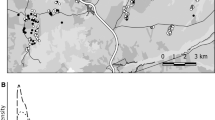Summary
I studied factors influencing dispersal distances in 30 young Spanish imperial eagles (Aquila adalberti) radio-tagged in southwestern Spain in 1986–1990. The mean dispersal distance between the natal nest and the settling area was 138 km. Every young bird reached its maximum dispersal distance within 4 months of its departure from the natal population. No significant differences between the sexes were detected in maximum dispersal distance, but females spent more time in the more distant settling areas. Dispersal distance was not related to the date of departure from the natal population. Dispersal distance was significantly longer for birds that hatched earlier and that had lower blood urea levels, indicating that better-nourished young had longer displacements. These results are not in accordance with the competitive displacement hypothesis.
Similar content being viewed by others
References
Baker MC, Newaldt LR (1978) Song dialects as barriers to dispersal in white-crowned sparrows, Zonotrichia leucophrys. Evolution 32:712–722
Belthoff JR, Ritchison G (1989) Natal dispersal of eastern screechowls. Condor 91:254–265
Buechner M (1987) A geometric model of vertebrate dispersal: tests and implications. Ecology 68:310–318
Dhondt AA (1979) Summer dispersal and survival of juvenile great tits in southern Sweden. Oecologia 42:139–157
Drilling NE, Thompson CF (1988) Natal and breeding dispersal in house wrens (Troglodytes aedon). Auk 105:480–491
Ferrer M (1990a) Dispersión juvenil de la población de águilas imperiales del Parque Nacional de Doñana. Ph.D. thesis, Universidad de Sevilla
Ferrer M (1990b) Hematological studies in birds. Condor 92:1085–1086
Ferrer M (in press) Reduction in hunting success and settlement strategies in young Spanish imperial eagles. Anim Behav
Ferrer M, Calderón J (1990) The Spanish imperial eagle Aquila adalberti in Doñana National Park: a study of population dynamics. Biol Conserv 51:151–161
Ferrer M, De le Court C (1992) Sex determination in the Spanish imperial eagle. J Field Ornithol 62:359–364
Ferrer M, Garcia-Rodriguez T, Carrillo JC, Castroviejo J (1987) Hematocrit and blood chemistry values in captive raptors. Comp Biochem Physiol 87A:1123–1127
Garcia-Rodriguez T, Ferrer M, Carrillo JC, Castroviejo J (1987a) Metabolic responses of Buteo buteo to long-term fasting and refeeding. Comp Biochem Physiol 87A:381–386
Garcia-Rodriguez T, Ferrer M, Recio F, Castroviejo J (1987b) Circadian rhythms of determined blood chemistry values in buzzards and eagle owls. Comp Biochem Physiol 88A:663–669
Gonzalez LM (1989) Historia natural del águila imperial ibérica. Ph.D. thesis, Universidad Autonoma de Madrid
Greenwood PJ (1980) Mating systems, philopatry and dispersal in birds and mammals. Anim Behav 28:1140–1162
Greenwood PJ, Harvey PH, Perrins C (1979) The role of dispersal in the great tit (Parus major): the causes, consequences and heritability of natal dispersal. J Anim Ecol 48:123–142
Jeffrey DA, Peakall DB, Miller DS, Herzberg GR (1985) Blood chemistry changes in food-deprived herring gulls. Comp Biochem Physiol 81A:911–913
Johnson ML, Gaines MS (1990) Evolution of dispersal: theoretical models and empirical tests using birds and mammals. Annu Rev Ecol Syst 21:449–480
Kenward RE (1987) Wildlife radio tagging. Academic Press, London
Korpimäki E, Lagerström M (1988) Survival and natal dispersal of fledglings of Tengmalm's owl in relation to fluctuating food conditions and hatching date. J Anim Ecol 57:433–441
Korpimäki E, Lagerström M, Saurola P (1987) Field evidence for nomadism in Tengmalm's owl Aegolius funereus. Ornis Scand 18:1–4
Lowther PE (1979) Growth and dispersal of nestling house sparrows: sexual differences. Bird Band 51:23–29
Matthysen E, Schmidt K (1987) Natal dispersal in the nuthacht. Ornis Scand 18:313–316
Miller GL, Carroll BW (1989) Modelling vertebrate dispersal distances: alternatives to geometric distribution. Ecology 70:977–986
Moore J, Ali R (1984) Are dispersal and inbreeding avoidance related? Anim Behav 32:94–112
Moore WS, Dolbeer RA (1989) The use of banding recovery data to estimate dispersal rates and gene flow in avian species: case studies in the red-winged blackbird and common grackle. Condor 91:242–253
Murray BG (1967) Dispersal in vertebrates. Ecology 48:975–978
Newton I, Marquiss M (1983) Dispersal of sparrowhawks between birthplace and breeding place. J Anim Ecol 52:463–477
Noordwijk AJ van (1984) Problems in the analysis of dispersal and a critique on its ‘heritability’ in the great tit. J Anim Ecol 53:533–544
Okumura J, Taski I (1969) Effect of fasting, refeeding and dietary protein levels on uric acid and ammonia content of blood, liver and kidney in chickens. J Nutr 97:316–320
Rodgers AR, Klenner WE (1990) Competition and the geometric model of dispersal in vertebrates. Ecology 71:818–822
Waser PM (1985) Does competition drive dispersal? Ecology 66:1171–1175
Weise CM, Meyer JR (1979) Juvenile dispersal and development of site-fidelity in the black-capped chickadee. Auk 96:40–55
Author information
Authors and Affiliations
Rights and permissions
About this article
Cite this article
Ferrer, M. Ontogeny of dispersal distances in young Spanish imperial eagles. Behav Ecol Sociobiol 32, 259–263 (1993). https://doi.org/10.1007/BF00166515
Received:
Accepted:
Issue Date:
DOI: https://doi.org/10.1007/BF00166515




